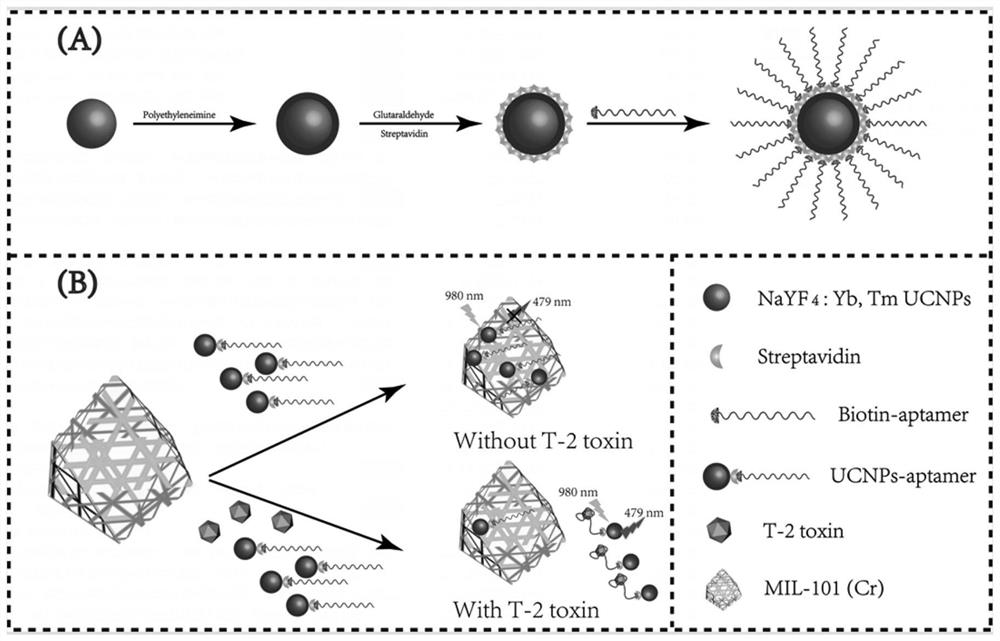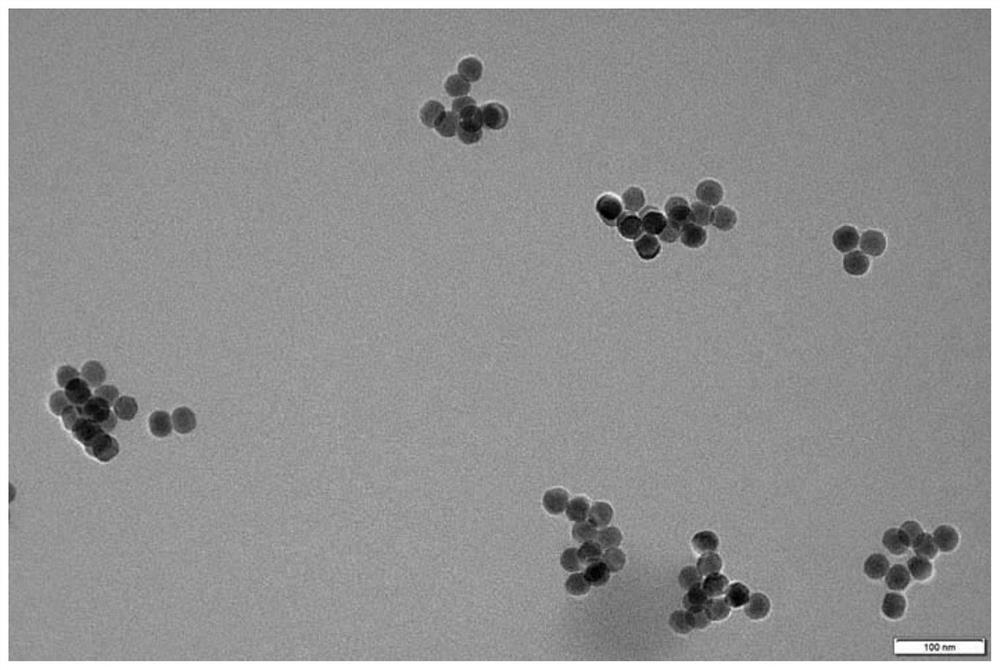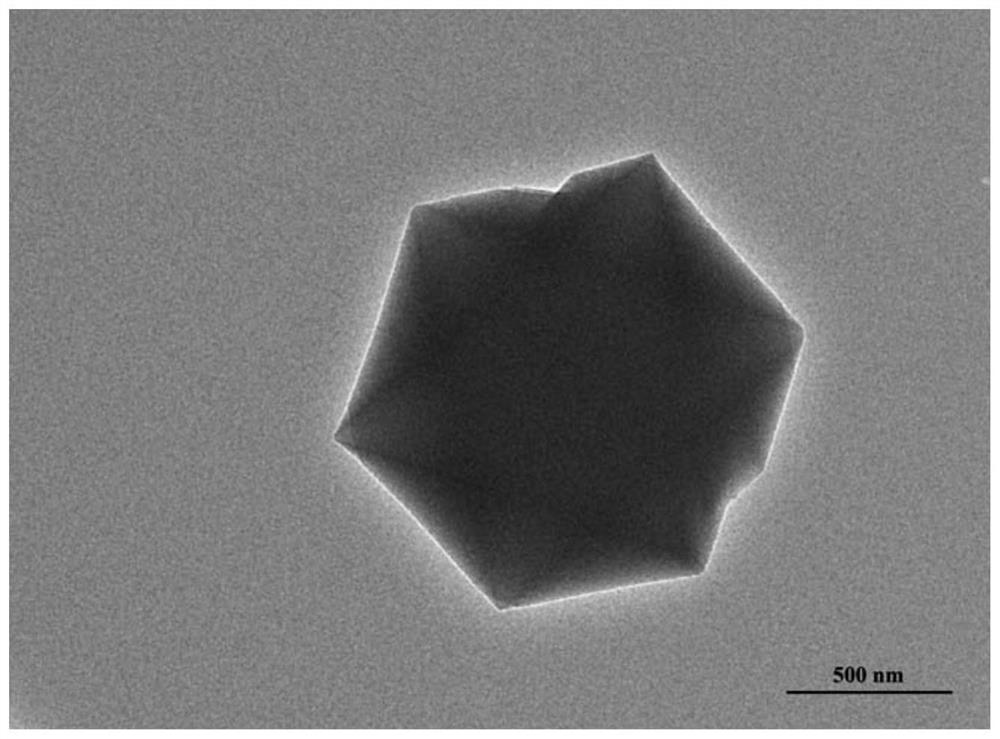Method and kit for fluorescence detection of micromolecular mycotoxin based on metal organic framework and upconversion nanoparticles
A metal-organic framework and nanoparticle technology, which can be used in fluorescence/phosphorescence, material analysis by optical means, measurement devices, etc., can solve the problems of high detection cost, difficult to popularize and use on a large scale, cumbersome operation steps, etc., to achieve applicability The effect of strong, stable fluorescence intensity and low background value
- Summary
- Abstract
- Description
- Claims
- Application Information
AI Technical Summary
Problems solved by technology
Method used
Image
Examples
Embodiment 1
[0046] This example is used to illustrate the rapid detection kit and detection method of T-2 toxin of the present invention. The specific implementation steps are as follows:
[0047] 1) Preparation and modification of upconversion nanoparticles modified with small molecule mycotoxin aptamers
[0048] (a) 0.78mmol YCl 3 ·6H 2 O, 0.2mmol YbCl 3 ·6H 2 O and 0.02 mmol TmCl 3 ·6H 2 O was dissolved in 4 mL of aqueous solution and added to a 100 mL three-necked flask containing 9 mL of OA and 15 mL of 1-ODE.
[0049] (b) The solution was stirred at room temperature for 10 minutes and heated at 150° C. for 1.5 hours to remove water and form the lanthanide oleate complex. At this time, the solution was transparent and light yellow, and then cooled to 50°C.
[0050] (c) Dissolve in 10mL CH 3 2.5 mmol NaOH and 4 mmol NH in OH 4 F was added to the above mixture and stirred at 50°C for 30 minutes. Set the system at N 2 Heated to 100°C in atmosphere for 1 hour to remove CH 3 ...
Embodiment 2
[0060] This example is used to illustrate a method for detecting T-2 toxin in corn flour with a fluorescent aptasensor based on metal-organic frameworks and up-conversion nanoparticles of the present invention. The up-conversion nanoparticles prepared in Example 1 were used to detect Needles and Metal Organic Framework MIL-101(Cr).
[0061] Specifically include the following steps:
[0062] 1) Add T-2 toxin to water at three different concentrations: 1 ng / mL, 5 ng / mL and 20 ng / mL. 1 g of corn flour was mixed with 10 mL of extraction solvent (methanol:water=6:4 (v / v)) containing various concentrations of T-2 toxin.
[0063] 2) The sample was vortexed for 5 minutes, then centrifuged at 13000 rpm for 10 minutes, and the supernatant was collected.
[0064] 3) In the buffer solution containing the upconverting nanoparticle probe (100 μL, 0.5 mg / mL), add 50 μL of each of the supernatants extracted from three types of corn, and incubate at 37° C. for 0.5 h.
[0065] 4) Add an equa...
Embodiment 3
[0069] This example is used to illustrate a method for detecting T-2 toxin in beer with a fluorescent aptasensor based on metal-organic frameworks and upconversion nanoparticles, using the upconversion nanoparticle probe prepared in Example 1 and Metal Organic Framework MIL-101(Cr).
[0070] 1) The beer was refrigerated at 4°C for 30 minutes or degassed by ultrasonic waves before use, and different concentrations of T-2 toxin were added to the beer, and then 10 μL of the mixture was added to 990 μL of 10 mM Tris-HCl to finalize the T-2 toxin. Concentrations were 1ng / mL, 5ng / mL and 20ng / mL. Three concentrations of samples to be tested were obtained.
[0071] 2) Add 50 μL each of the three beer sample solutions to the buffer containing the upconverting particle probe (100 μL, 0.5 mg / mL), and incubate at 37° C. for 0.5 h.
[0072] 3) Add an equal volume of MOFs suspension into a centrifuge tube and mix well, then shake slowly and react at 37°C for 20min.
[0073] 4) Then use a...
PUM
 Login to View More
Login to View More Abstract
Description
Claims
Application Information
 Login to View More
Login to View More - R&D
- Intellectual Property
- Life Sciences
- Materials
- Tech Scout
- Unparalleled Data Quality
- Higher Quality Content
- 60% Fewer Hallucinations
Browse by: Latest US Patents, China's latest patents, Technical Efficacy Thesaurus, Application Domain, Technology Topic, Popular Technical Reports.
© 2025 PatSnap. All rights reserved.Legal|Privacy policy|Modern Slavery Act Transparency Statement|Sitemap|About US| Contact US: help@patsnap.com



